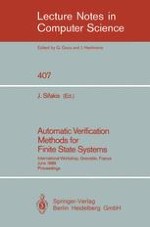This volume contains the proceedings of a workshop held in Grenoble in June 1989. This was the first workshop entirely devoted to the verification of finite state systems. The workshop brought together researchers and practitioners interested in the development and use of methods, tools and theories for automatic verification of finite state systems. The goal at the workshop was to compare verification methods and tools to assist the applications designer. The papers in this volume review verification techniques for finite state systems and evaluate their relative advantages. The techniques considered cover various specification formalisms such as process algebras, automata and logics. Most of the papers focus on exploitation of existing results in three application areas: hardware design, communication protocols and real-time systems.
